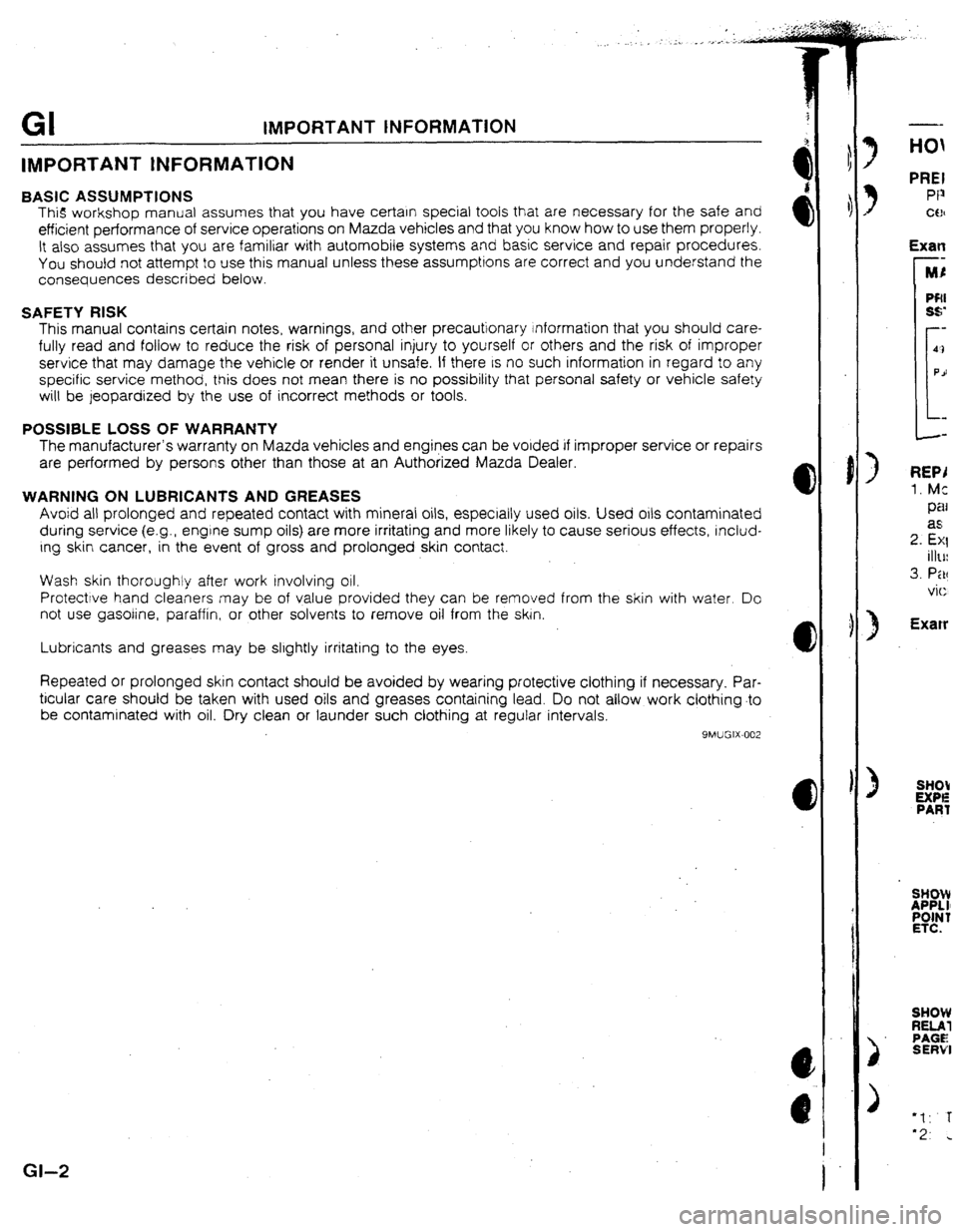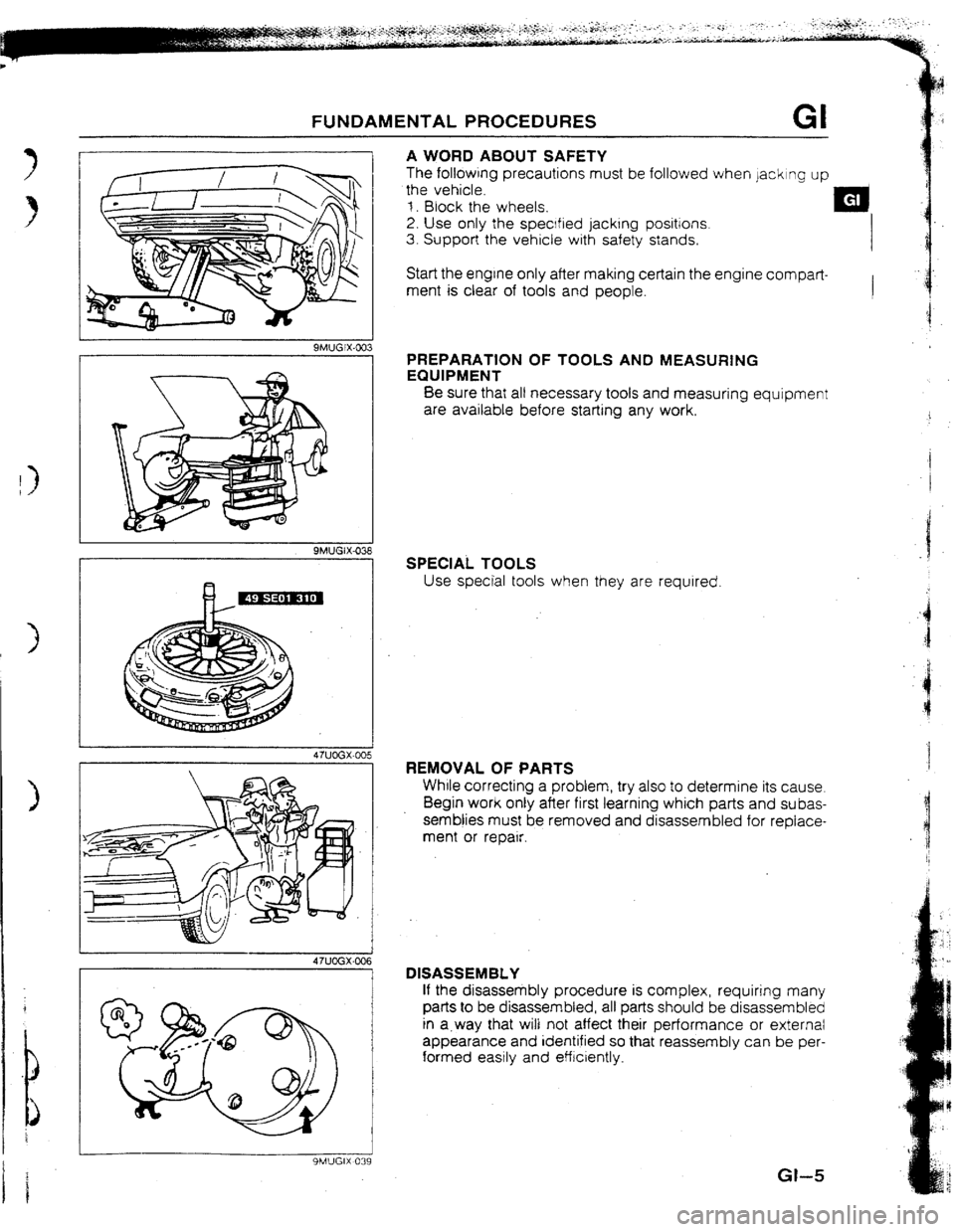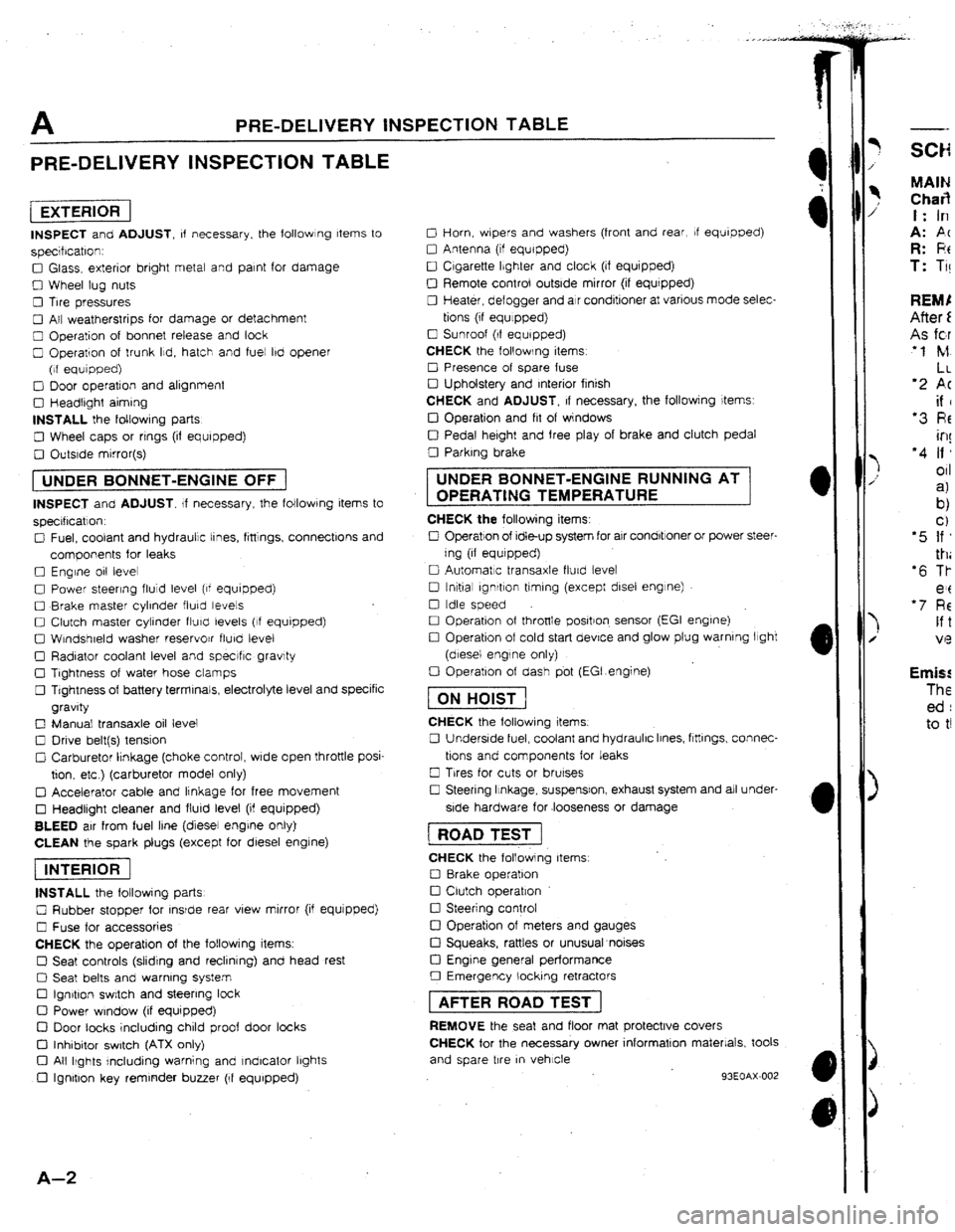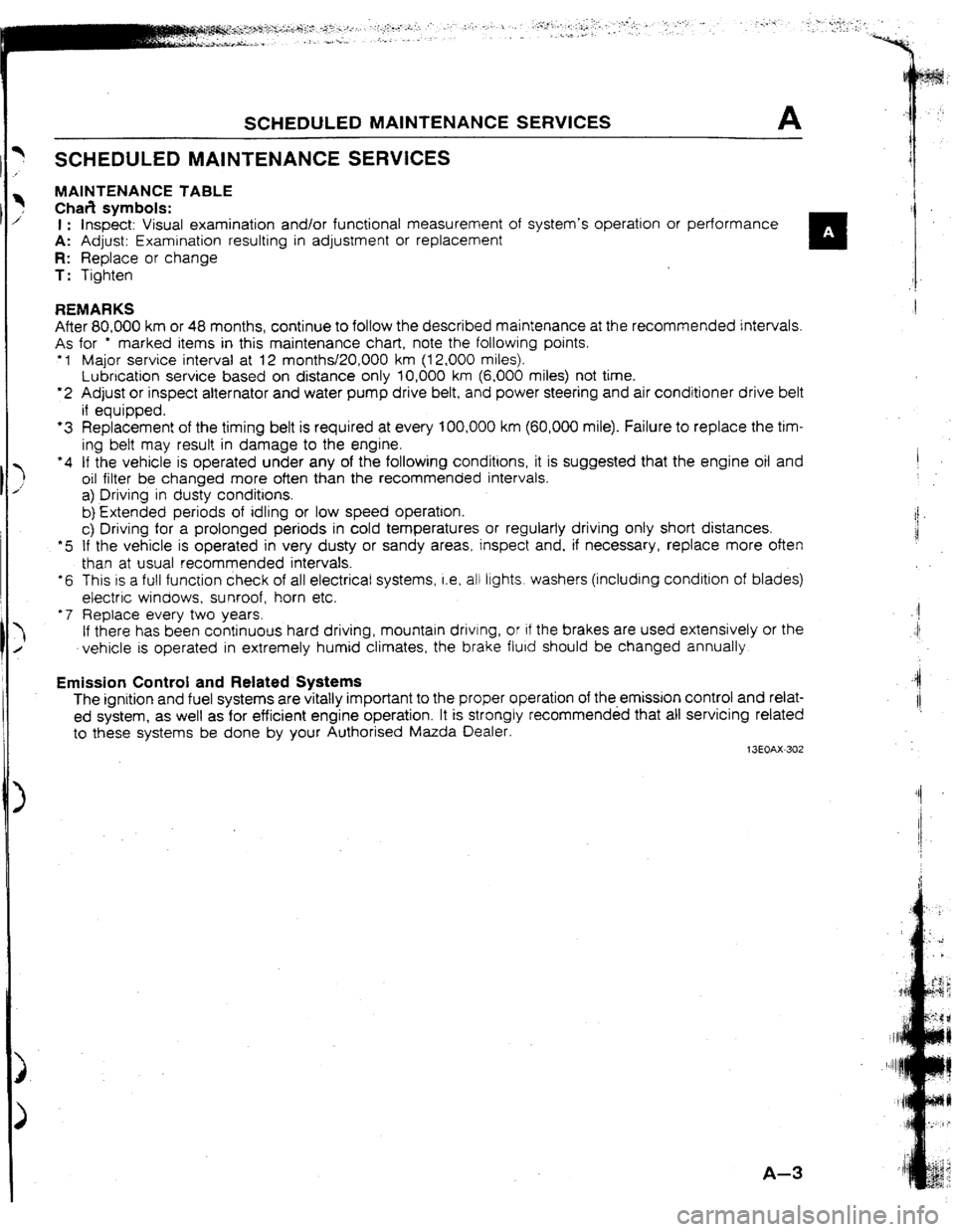engine MAZDA 323 1992 Workshop Manual Suplement
[x] Cancel search | Manufacturer: MAZDA, Model Year: 1992, Model line: 323, Model: MAZDA 323 1992Pages: 279, PDF Size: 24.15 MB
Page 5 of 279

GI tMPORTANT INFORMATION
IMPORTANT INFORMATION
BASIC ASSUMPTIONS
This workshop manual assumes that you have certarn special tools that are necessary for the safe and
efficient performance of service operations on Mazda vehicles and that you know how to use them properly.
It also assumes that you are familiar with automobile systems and basic service and repair procedures.
YOU should not attempt to use this manual unless these assumpttons are correct and you understand the
consequences described below.
SAFETY RtSK
This manual contains certain notes, warnings, and other precautionary information that you should care-
fully read and follow to reduce the risk of personal injury to yourself or others and the risk of improper
service that may damage the vehicle or render it unsafe. If there IS no such information in regard to any
specific service method, this does not mean there is no possibility that personal safety or vehicle safety
wili be jeopardized by the use of incorrect methods or tools.
POSStBLE LOSS OF WARRANTY
The manufacturer’s warranty on Mazda vehicles and engines can be voided if improper service or repairs
are performed by persons other than those at an Authorked Mazda Dealer.
WARNtNG ON LUBRtCANTS AND GREASES
Avoid all prolonged and repeated contact with mineral oils, especially used oils. Used oils contaminated
during service (e+g., engine sump oils) are more irritating and more likely to cause serious effects, includ-
ing skin cancer, in the event of gross and prolonged skin contact.
Wash skin thoroughly after work involving 011.
Protective hand cleaners may be of value provided they can be removed from the skin with water Do
not use gasoline, paraffin, or other solvents to remove oil from the skrn.
Lubricants and greases may be slightly irritating to the eyes.
Repeated or protonged skin contact shoutd be avoided by wearing protective clothing if necessary. Par-
ticular care should be taken with used oils and greases containing lead. Do not allow work clothing .to
be contaminated with oil. Dry clean or launder such clothing at regular intervals.
9MtlGIX-002
Gt-2 REP/
I. Mc
pai
2. &
illu:
3. Put
vir:
Exarr
SHOI
EXPE
PART
SHOW
REUl
PAGE
SEWI
‘1: T
*2: c
Page 8 of 279

FUNDAMENTAL PROCEDURES GI
A WORD ABOUT SAFETY
The following precautions must be followed when jacking up
the vehicle.
t . Block the wheels.
2. Use only the specfred jacking positions.
3. Support the vehicle with safety stands.
Start the engine only after making certain the engine compart-
ment is clear of tools and people. j
9MUGtX-003 PREPARATION OF TOOLS AND MEASURING
EQUIPMENT
8e sure that al! necessary toois and measuring equipment
are available before starting any work.
SPECIAL TOOLS
Use special tools when they are required.
47UOGX-Cm I 1 REMOVAL OF PARTS
While correcting a problem, try also to determine its cause
Begin work only after first learning which parts and subas-
semblies must be removed and disassembled for replace-
ment or repair. >
DISASSEMBLY
If the disassembly procedure is complex, requiring many
parts to be disassembled, all parts should be disassembled
in a.way that wiii not affect their performance or external
appearance and identified so that reassembly can be per-
formed easily and efficiently. I J
9MUGIX 039
a-5
I 1
Page 12 of 279

MAlNTENANCE NOTE GI
.
FREE ROLLER
I t 3EGlX-304
MAlNTENANCE NOTE
SPEEDOMETER TESTER CHECK
Caution
l Do not clutch abruptly.
l Do not attempt rabbit starts or accelerate quickly. 13EGIX-302
[Front wheel free-roller method]
1. Set the free roller securely on the floor under the front wheels
by matching it to the wheel base and front tread.
2. Place the vehicle softly on the tester and free roller.
3. Start the engine, and engage the clutch softly at a low speed
in 2nd gear; then gradually increase the speed.
4. Upon completion of the test, stop the engine by gradually
decelerating with soft braking.
[Front wheel jack-up method1
1’. Place the rear wheels on the roller.
2. Jack up the front wheels and mount on a safety stand.
3. Start the engine, and engage the clutch softly at a low speed
in 2nd gear; then gradually increase the speed.
Caution
l When using either the front wheel free-roller meth-
od or front wheel jack-up method, secure the vehi-
cle to prevent forward and lateral movement by
attaching towing hardware (chain or wire) to the
front and rear tow hook or tie-down hook.
BRAKE TESTER CHECK
Caution
. To stabilize the drag force of the viscous coupling,
conduct the brake test after the speedometer test.
1. Place the wheels to be tested (front or rear) on the roller.
2. Shift itit0 NEUTRAL.
3. Drive the tester roller and check.
a-9
Page 13 of 279

GI MAINTENANCE NOTE
VIEWED
.OM BELOW
‘REE
13EGfX-307
I
I t3EGIX-308 CHASSIS DYNAMOMETER CHECK
Caution
l Do not clutch abruptly. l Do not attempt rabbit starts or accelerate quickly.
1. Remove the propeller shaft.
2. Lock the center differential (2WD).
3. Place the front wheets on the roller.
4. Lock the rear wheels and apply the parking brake.
5. Drive the tester roller and check.
6. Upon completion of the test, gradually decelerate with soft
braking and stop the engine.
7. When the test is done, return the differential lclck rod to the
free condition (4WD) and reinstall the propeller shaft.
WHEEL BALANCER (On-the-car Balance)
1.
Jack up all four wheels. Support the wheels to be checked
(front or rear) with the wheel balancer sensor stand and the
remainrng wheels with safety stands.
2. Set the on-the-car balancer. With the center differential in
free condition, drove the tires with the engine; then check.
Page 15 of 279

GI IDENTIFICATION NUMBER tOCATlONS/UNlTS/ABBREVIATlONS
IDENTIFICATION NUMBER LOCATIONS
VEHICLE tDENTtRCATtUN NUM8ER (VIM) ENGINE MODEL AND NUMBER
I
UNITS
N.rn { kgf m or kgfcm,
f-t&f or tn.lbf 1 . . . . . . . . . . . . . . . . Torque
rpm ._ . . . Revolutions per minute
A.. ,_...___.... Ampere(s)
v I... Volt(s)
$2 . .._..__......_.....__... Ohm(s) (resls‘tance)
kPa { kgflcm*, psr] . . . . . . . Pressure
{usually positive)
mmHg I inl-lg ] . . . . . . . . . Pressure
(usually negatrve)
W . . . ._ .._.__ .._ . . . . . . ..,......... Watt
titers [US qt, Imp qt 1 . V&me
mm { rn 1 . . . . . . . . . . . . . . . . . . . . . . . Length
89UOGX-006
ABBREWATIONS
ABDC _. . . . . . . . . . . After bottom dead
center
A/C . . . . . . . ._.. _. . . . . . . . . Air conditioner
ACC .__ . . . . . . . Accessones
ATX .._ ._ . . . . . . . . . . . . . . Automate transaxle
ATDC _.. __ _. . . . . After top dead center
ATF ,... ._....__._.. Automatic transmission
fluid
BAC ._ . . . . . . . . . . . . . . ,. Bypass air control
BBDC _. . . . . . . . . . . . . .._. Before bottom dead
center
BTDC ., ._._... . . . Before top dead center
CPU . . . . . . . . . Central processrng unit EC-AT
........................... Electronrcally-controlled
automatic transmlsslon
ECU ._ ....................... Engine control unit
EG 1 ..................... Electronc gasoll ne
injectron
E/L. ............................ Electrrcal load
EX .............................. Exhaust
IC ................................ Integrated clrcult
IGN ........................... lgnrtlon
IN ..... ........................ Intake
INT
............................... Intermittent
ISC ............................ Idle speed control
U-l ................................
Left hand
M..
........................... Motor
MIL
........ ...................... MatfunctIon Indicator
iamp
MTX. ........................... Manual transaxle
00.. .............................. Overdnve
Of F .............................. Swrtch off
ON
............................... Switch
on
PCV .............................. Positive crankcase
ventilation
PRC .......................... Pressure regulator
control
P/S ............................. Power steerrng
P/W ............................
Power window
RH ............................... Rlght hand
SST
............................. Special service tool
ST.. ............................... Starl
SW.. ............................. Switch
TDC. ............................ Top dead center
4WD .............................
4-wheel drive
03UGIX-802
INS7
If a t’
and
Whe
1, II-!
2. II-!
3. E-
4. Dr
W-1 2
Page 17 of 279

..,. .
a
._
GI CAUTKN
PRECAUTIONS TO TAKE WHEN SERVICING AN ELECTRICAL SYSTEM l Note the following items when servicing the electrical system.
l Do not alter the wiring or electrical equipment in any way; this may damage the vehicle or cause a fire
from short-circuiting a circuit or overloading it.
l The negatrve (-) battery cable must be removed first and
rnstalled last. l Do not reptace with fuses exceedrng specified capacity
Cautron
l 8e sure that the ignitton and other switches are off
before disconnectrng or connecting the battery cables.
Failure to do so may damage the semrconductor
components. Caution l Repfacing a fuse with one of a larger capacrty than
desrgnated may damage components or cause a frre.
l Secure harnesses with provrded clamps to take up slack. l Tape areas of the harness
that may rub or bump l When mounting
components, be sure the
against sharp edges to
protect rt from damage. harness IS not caught or
damaged.
Caution
l Clamp all harnesses near vibratrng components (for
example, the engine) to remove slack and to prevent
contact resultrng from vibration. i Drsconnect heatsensitive l Make sure that the
parts (for example, relays
and ECU) when performing connectors are securely
connected when installed.
l Do not handle electrical components roughly or drop
them. maintenance (such as
weldrng) where
temperatures may exceed
80°C [176OFj.
-*
HI
Page 21 of 279

A PRE-DELIVERY INSPECTION TABLE
PRE-DELIVERY INSPECTION TABLE
[EXTERlORI
INSPECT and ADJUST, of necessary. the followlng Items to
specrfrcatron:
0 Glass, exterior bright metal and paint for damage
0 Wheel lug nuts
0 Tire pressures
0 All weatherstrips for damage or detachment
0 Operation of bonnet release and look
0 Operation of trunk Ild, hatch and fuel lbd opener
(of equipped)
0 Door operation and alignment
0 Headtrght aiming
INSTALL the foltowrng parts
0 Wheel caps or rrngs (if equipped)
0 Outsrde mirror(s)
1 UNDER BONNET-ENGINE OFF j
INSPECT and ADJUST. If necessary, the following items to
specrflcatlon.
0 Fuel, coolant and hydraulic tines, fittings, connectlons and
components for leaks
0 Engine 011 level
0 Power steering fluid level (of equipped)
0 Brake master cylinder fluky levels
0 Clutch master cylinder fturcl levels (If equipped)
0 Wtndshreld washer reservojr flurd level
0 Radiator coolant level and specrfic gravity
0 Tightness of water hose clamps
0 Tightness of battery terminals, electrolyte level and specific
gravity
0 Manual transaxle oil level
0 Drive belt(s) tension
Cl Carburetor lrnkage (choke control, wrde open throttle posi-
tion. etc ) (carburetor model only)
q Accelerator cable and linkage for free movement
0 Headlight cleaner and flurd level (if equipped)
BLEED air from fuel line (diesel engrne only)
CLEAN the spark plugs (except for diesel engine)
piEi6F]
INSTALL the following parts
0 Rubber stopper for rnsrde rear view mirror (if equjpped)
0 Fuse for accessories
CHECK the operation of the following items.
0 Seat controls (sliding and reclining) and head rest
0 Seat belts and warning system
Cl Ign&on switch and steering lock
0 Power window (if equipped)
D Door tacks including child proof door locks
Cl Inhibitor switch (ATX only)
Cl All Ikghts rncluding warning and Indicator lbghts
0 Ignition key reminder buzzer (If equipped)
A-Z
0 Horn, wbpers and washers (front and rear, If equipped)
0 Antenna (tf equipped)
0 Cigarette Ibghter and clock (if equipped)
0 Remote control outside mirror (if equrpped)
0 Heater, defogger and air conditioner at various mode selec-
tions (if equlppedj
0 Sunroof (If equipped)
CHECK the following items
0 Presence of spare fuse
0 Upholstery and Interior finish
CHECK and ADJUST, If necessary, the followjng items:
IJ Operation and fit of windows
0 Pedal height and free play of brake and clutch pedal
0 Parking brake UNDER BONNET-ENGINE RUNNING AT
OPERATING TEMPERATURE
CHECK the following items:
0 Operation of Idle-up system for air condbtroner or power steer-
ing (if equrpped)
0 Automatic transaxle flurd levet
0 tnltial ignrtlon timing (except disel engine)
0 Idle speed
0 Operation of throttle positron. sensor (EGI engrne)
0 Operation of cold start device and glow plug warning light
(diesel engine only)
0 Operation of dash pbt (EGI.engine)
fTiGGJ
CHECK the following items.
0 Underside fuel, coolant and hydraulic Irnes, ftttlngs, connec-
tions and components for leaks
0 Trres for cuts or brurses
0 Steering Itnkage, suspensron, exhaust system and all under-
side hardware for .looseness or damage 1 ROAD TEST j
CHECK the following items
0 8rake operation
0 Clutch operation
0 Steering control
!ZI Operation of meters and gauges
Cl Squeaks, rattles or unusual noises
Cl Engine general performance
0 Emergency locking retractors 1 AFTER ROAD TEST ]
REMOVE the seat and floor mat protective covers
CHECK for the necessary owner information materials, took
and spare tire
m vehicle
93EOAX-002
-- MAIN Char3 t: In
A: PC R: F!t T: Ti! Emis! The ed : to t!
Page 22 of 279

SCHEDULED MAINTENANCE SERVICES A
SCHEDULED MAINTENANCE SERVICES
MAINTENANCE TABLE
Chafi symbols:
1 : Inspect: Visual examination and/or functional measurement of system’s operation or
performance , A: Adjust: Examination resulting in adjustment or replacement
n
R: Replace or change
T: Tighten
REMARKS
After 80,000 km or 48 months, continue to follow the described maintenance at the recommended intervals.
As for * marked items in this maintenance chart, note the following points.
+ 1 Major service interval at 12 months/20,000 km (12,000 miles).
Lubrication service based on distance only 10,000 km (6,000 miles) not time.
l 2 Adjust or inspect alternator and water pump drive belt, and power steering and air conditioner drive belt
if equipped.
‘3 Replacement of the timing belt is required at every 100,000 km (60,000 mile). Failure to replace the tim-
ing bett may result in damage to the engine.
‘4 tf the vehicle is operated under any of the following conditions, it is suggested that the engine oil and
oil filter be changed more often than the recommended intervals.
a) Driving in dusty conditions. I
:
b) Extended periods of idling or low speed operation. i
i!
c) Driving for a prolonged periods in cold temperatures or regularly driving onty short distances.
*5 If the vehicle is operated in very dusty or sandy areas, inspect and, if necessary, replace more often
than at usual recommended intervals.
l 6 This IS a full function check of all electrical systems, i.e, atl
ltghts. washers (including condition of blades)
electric windows, sunroof, horn etc.
‘7 Replace every two years. $1
‘I
If there has been continuous hard driving, mountain
drivtng, or if the brakes are used extensively or the
vehicle is operated in extremely humid climates, the brake fluid should be changed annually.
Emission Control and Related Systems
The ignition and fuel systems are vitally important to the proper operation of the-emission control and relat-
ed system, as well as for efficient engine operation. It is strongly recommended that all servicing related
to these systems be done by your Authorised Mazda Dealer.
13EOAX-302 -4
I!
A-3
Page 23 of 279

A SCHEDULED MAtNTENANCE SERVtCES (Europe)
Maintenance Number of months or km (miles), whichever comes first
Months” - 6 12 18 24 30 36 42 48
Kllometers 1,000 10,000 20,000 30,000 40,000 50,000 60,000 70,000 80,000
{Miles)
(600) (6,000) f[t2,000) (18,000) (24,000) (3U,OOO) (36,000) (42,000) {48,000), Engine
Intake and exhaust manrfold nuts (Bolts)
Drive belts”
i Engine trmlng beltW3
Engine oil (Turbo)‘4
01 filter
l *
Cool!ng system (Includtng
coolant level adlustment)
Engrne coolant T T T
A A A
A A
Replace every 100,000 km (60,000 miles)
Replace every 5,000 km (3,000 miles) or 6 months
R R R R R 1 R R R
I I I I
I
Replace every 2 years Fuel system
Idle speed
Air cleaner element * 5
Fuel
falter
Fuel Ilnes and hoses Ignition system
A f 1
I R I R
R R
I I f t I ~
lnlttal rgnrtloh trmlng 1 I I I I I I I I
Spark plugs A
A. A A
Spark plugs (Only for Sweden) Adjust every 30.000 km (t8.000 mrls) Evaporative emission control system
Throttle sensor Throttle sensor (Only for Sweden)
Evaporative system
Evaporatrve system (Only for Sweden) 1 A 1 1 A 1 1 A 1 ) A
Adjust every 80,000 km (48,000 miles)
1 I 1 1 I’ 1 1 I 1 1 I
Inspect every 80,000 km (48,000 mites) Electrical system
Battery electrolyte level and specific gravity 1 I f I I I
All Electrical system
l ’ 1 I
I 1 I I I
1 . 1 I I
Headlight alrgnment 1 A A A . A. Chassis and body
t 3EOAX-303
A-4 Chas
SW31 Rear
Tires
Hing
Seat
Page 25 of 279

B2
ENGINE
(DOHC)
1 FEATURES j
OUTLINE ................................................
B2- 2
OUTLINE OF CONSTRUCTION..
.............. B2- 2
SPEClFICATlONS
..................................
82- 2
INTERCHANGEABILITY ..........................
B2- 3
PISTON ...............................................
82- 4
CONNECTING ROD ...............................
82- 5
CRANKSHAFT PULLEY ..........................
B2- 6
EXHAUST VALVE ..................................
B2- 7
INSTRUCTION FOR HANDLING METALLIC
SODllJM~FlLLED EXHAUST VALVE .........
82- 8
SUPPLEMENTAL SERVICE INFORMATION 820 9
4
13E082-301